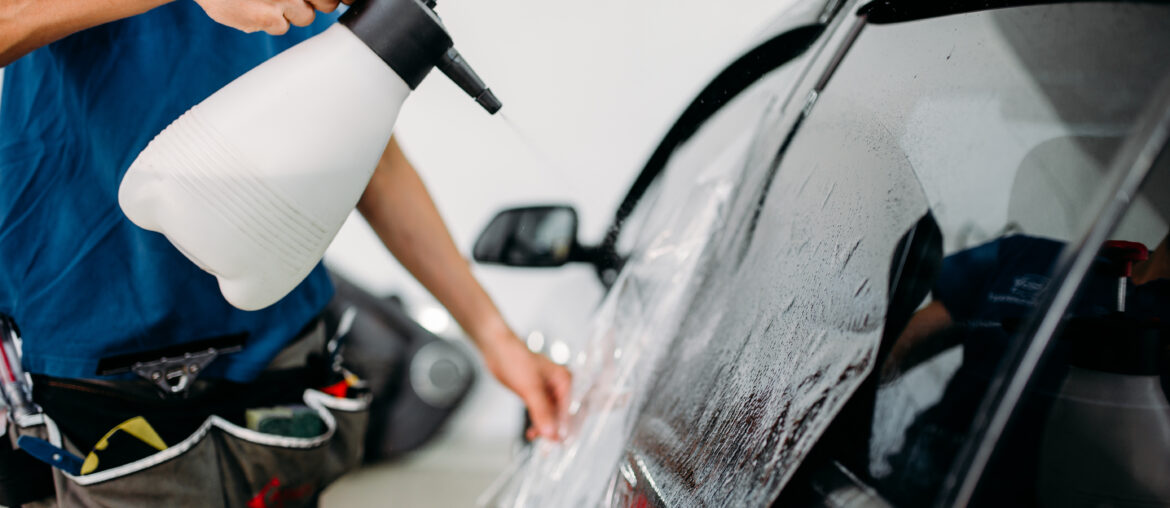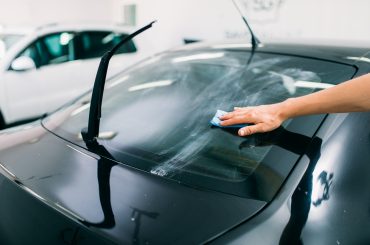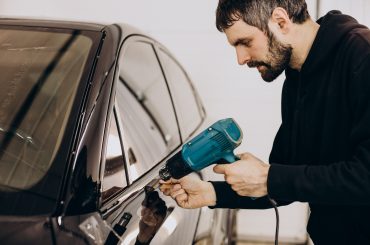Need help to make an informed decision on window tint percentage? Feel like there’s more to it than looking up a chart? We’ve got you covered.
Here is complete coverage of all the details you need to know before making a choice with your window tints. By the end of this article, you’ll know the best window tint percentage without having time, money, or your vehicle’s features compromised.

Table of Contents
Why Tint Your Car Windows?
Having a private space within your car isn’t the only reason you should have your windows tinted. It brings about healthier benefits like keeping out harmful UV rays to improve vehicle durability.
Further, it reduces glare alongside the chances of eye strain and improves heat reduction capabilities setting a cooler environment within the car. Not to forget the benefit that would easily be any automotive enthusiast’s top priority – improved aesthetics. refer to the article How Does Window Tint Reduce Heat Inside Our Cars?.
Available colors for window tinting
When it comes to a choice of color, any gearhead will find this a no-brainer. Black is our happy color.
Well, apart from this elegant and highly effective color, window tints can come in a range of other colors. list includes Classic Charcoal and Grey, which aren’t the flashiest as a reflective gold shade but are sufficient in getting the intended job done.
Some colors that go against the flow include Blue, Amber, Yellow, and Red. However, these tints may be of restricted shades or completely banned in some states in the U.S.
For more details about these, refer to our article on car window tinting color options.
Window Tint Laws are important.
The primary factor upon which you should base your tint percentage is the state laws. There would be no point in having an illegal tint on your vehicle for improved looks if you get pulled over, fined, and forced to remove the tint before you hit the roads again.
The Window Tint Laws in the U.S. vary from state to state, with some states being extremely strict. Therefore, before you make any decision whatsoever, know the laws to prevent unnecessary trouble.
You can check out our article, which consists of the window tint laws for each and every state quite briefly.
Window tint terms you need to know.
Before jumping onto the vital factors that help you make an informed decision, here are some important technical terms on tinting windows:
- Factory Tint – The natural tint within the glass
- Aftermarket Tint – A removable and replaceable film that is placed over the glass window.
- Front-side windows – Windows on the sides of the passenger and the driver, and not their forward-facing windshield.
- Rear-side windows – Any window that lies behind the front-side windows.
- Tint reflection – Reflectivity of window films, most often used to dictate reflectivity of metallic films.
- Restricted colors – Color tints that aren’t legal in the state(s). The previously mentioned colors Blue, Amber, Yellow, and Red, make it to this list.
- Visible Light Transmission (VLT) – A percentage measurement of how much visible light is able to penetrate through a surface, in this case, our vehicle’s windows. Internal VLT is the light penetrating from the vehicle interior to the outer environment. External IVT is the percentage of sunlight penetrating the vehicle’s interior from the outer environment. And yes, IVLT gives a measure of how much an outsider can see the interior, while EVLT is a measure of how much an insider can see the outdoors.
Both forms of VLT are pretty important from an observer’s and driver’s perspective. However, in the context of choosing a window tint for a vehicle, we will be using the Internal Visible Light Transmission the most often and denote it as VLT.
How to calculate the VLT
The calculation of VLT for a screen that comes out 100% clear, fresh from the factory, would be easy to calculate. You give it a tint of, say, 35%, and the VLT of the window would now be 35%.
However, this is not the case in most instances. Vehicle screens aren’t transparent on arrival and may be handed over with a VLT percentage below 100%, high-end translucent.
In this scenario, the VLT of the window before the tinting operation and the tinting percentage provided should be multiplied in order to obtain the final percentage.
Take, for example, a new window with a factory tint of 90%. If you were to have a 20% tint done on the windows, the final percentage of the window wouldn’t be 20% as perceived. Due to the combination of the factory and automotive tints, the resulting tint is 90% x 20% = 18%.
Is it bad to put a tint over a tint?
Like in the above example, vehicle owners who aren’t satisfied with their factory tint can apply an aftermarket tint. This will be the only option to reduce the window tint percentage from the factory tint. Once a factory tint is involved, the vehicle owner can only apply darker tones from thereon.
Never try to tint over the aftermarket tint. Instead, have it completely replaced with your newest choice. It is completely fine to tint over factory tint but not over aftermarket tint.
The process of tinting over tint requires much more skill and technique. Therefore, it is recommended to seek professional support. This will ensure you settle with the best tint option.
What are the different tint percentages?

With different shades of the tint come different benefits and drawbacks. Some changes may be desired to a certain type of users, while to another, not so much. In this section, we break down the major car tint percentages and their features so that you know which would be the best window tint for you.
- Fifty-Percent Tint
The tint with the least darkness on this list, a 50% tint, blocks half the VLT providing quite reasonable protection against UV rays, heat, and glare without sacrificing too much visibility.
Therefore, it is also the safest for a night drive on our list. However, the interior of the vehicle does not receive a darker effect, which would have been desirable for most individuals. Some individuals might even consider it an ineffective experience to the senses.
- Thirty-Five Percent Tint
What does a 35% tint look like? For those of you eager to know, it looks stylish, sleek, and alluring.
It is also capable of giving the vehicle a darker interior and good protection against UV radiation. If you value privacy without having any flags being raised and less visibility sacrificed during night drives, 35 tint is your best percentage for tinting your windows.
- Twenty-Percent Tint
Going further down the VLT percentage, the 20% window tint provides far more privacy for insiders.
To someone standing outside your car, the body outlines would be clear, yet much more distinct features such as the face would not be easily discernible. It’s a bargain to take because, during the night, a twenty percent tint could look much darker than it was intended to be, perhaps like a 15% window tint.
- Five Percent Tint
You might want to think twice about getting a 5% tint if you do not want any suspicion drawn towards you.
They are illegal in most states as the car’s interior is barely visible even to outsiders standing right next to the car during the day. This can also be quite challenging to drive around during the nighttime. Therefore, it is safe to say that a 5% Tint is not the safest option unless it’s for a Limo.
What percentage of tint is the darkest?
As the previous section concludes, the darkest percentage available for cars is 5% tint – allowing only 5% of visible light to permeate through the window. It is also termed “Limo Tint” as limousines are rarely the only exception for 5% tints being allowed.
What percent is factory tint?
15% window tint is usually the factory tint percentage. The value may range up to the 20% mark. In some instances, the best tint percentage may not be the factory tint. This is the exact reason why you would want an automotive tint.
Now that you know the basics of each tint let’s cut to the chase. Here’s how you select the best option for you.
How to select the ideal window tint percentage?
When choosing the best tint percentage, do not merely lookup a chart and make up your mind. The ideal window tint percentage would firstly be one that abides by state laws.
Next, an ideal percentage would be one that isn’t too low on internal visibility. One that gives you enough privacy but does not make you invisible to someone standing right next to your vehicle door.
Or, in other words, a percentage that strikes a balance between your need for privacy and the public’s need for security. Every state wants to ensure the chances of a break-in is less as the chances of a break-out through a car’s windows—the security of both the insiders and the outsiders’ matter.
Remember, going low on VLT only decreases your driving visibility, too, which might increase the risk of accidents. Lastly, ensure the car tint matches its aesthetics.
An Expert’s Tips for Choosing the Best Tint Percentage for Your car
Determine why you want a tint
- Is it privacy? Low window tint percentages would be the best choice.
- Visual comfort while driving? Moderate values would be the best choice for you. Low enough to reduce glare and eye strain but not too low to hinder night visibility.
- UV Protection? A moderate percentage would block almost all UV just as well as an extremely low tint percentage would.
Consider the Look of Your Car
Would darker car tint do justice to your vehicle? Higher percentages do not change the look of your car drastically, so the lower you go, the more cautions you’ll need to be.
Look at Other Cars
There’s no better way to get an idea of the ideal shade than by looking at other cars to avoid the same mishaps or steal the ideas from.
If you are looking for some inspiration instead, you can meet with a professional installation team, as they have plenty of samples to offer. Together with their tint percentage charts, you could visualize unique ideas better.
- Pick a High-Quality Film
Regardless of your countless attempts to pick the right percentage, it all goes in vain if your film isn’t up to par. Purchasing films online do not offer the best longevity and therefore result in the need for frequent maintenance.
The best practice would be to invest in a professional-grade film installed by expert window tinters to help save the trouble. After all, vehicle owners want their vehicles to look great in the long run.
- Get It Professionally Done
The film needs to be installed precisely without the inclusion of air bubbles as they look unappealing and may decolorize the tint over time. They will need to be replaced faster than they were put up, so we recommend you leave it to the professionals.
With the expertise and the right tools, you can ensure reliable results. After all, they come with a warranty and craftsmanship that you wouldn’t be offered if you DIY.
What is the best window tint percentage? – Answered
And that’s how we narrow down your choice of window tint option for your car. To summarize, know what your state laws permit and prohibit. This should be the foundation of your choice. The next factor would be to know your priorities: what objective to be fulfilled by tinted windows. Visualize and go through samples of how the chosen tint would look on your vehicle. Once you’ve narrowed down the options through our detailed description on each tint, get professional clarification and support to pick a high-quality film and get the job done.
Here at Tint Max, we’re always ready for service. Whether you’ve chosen your desired tint or if you need more advice on selecting the best window tint, feel free to contact us now.







